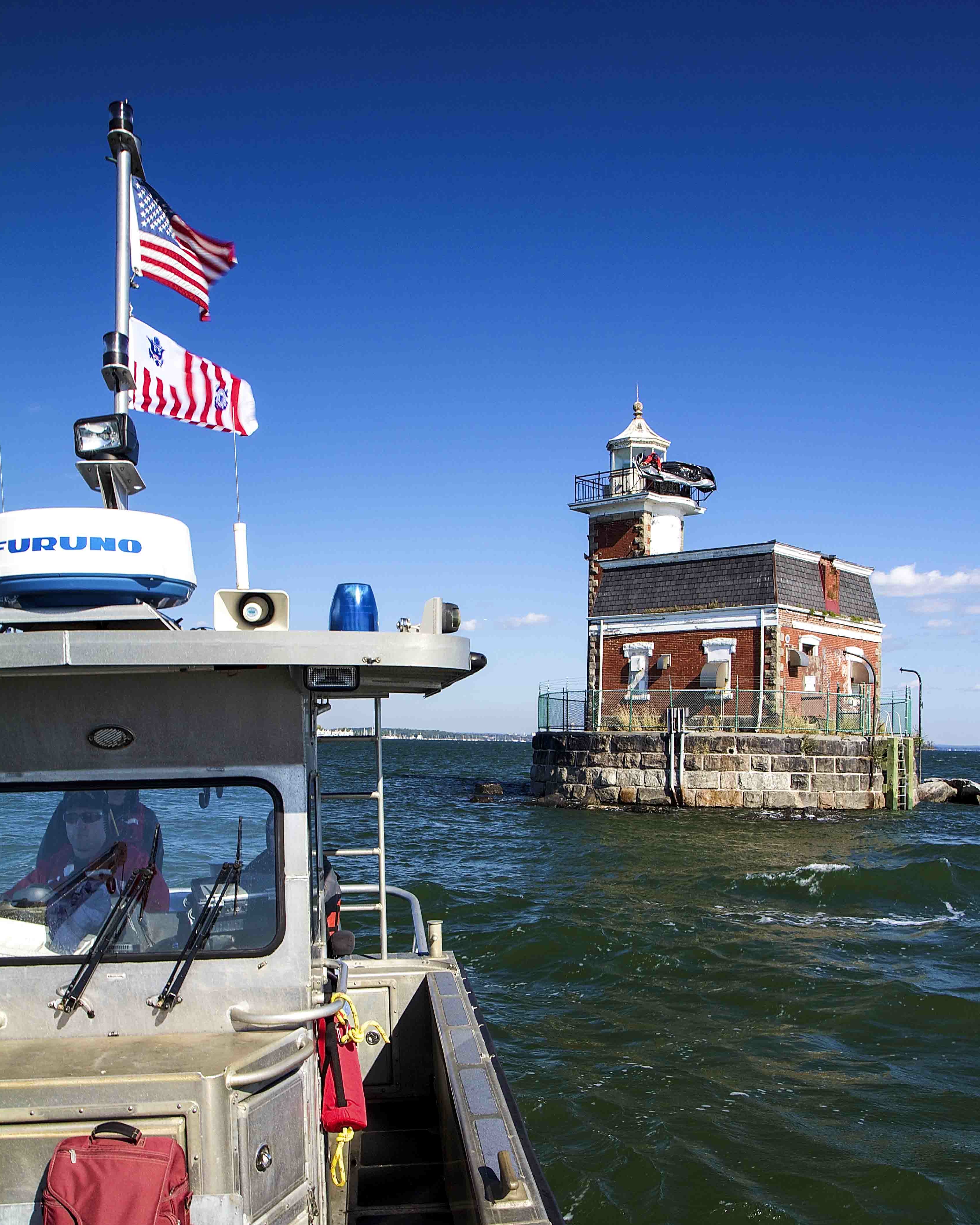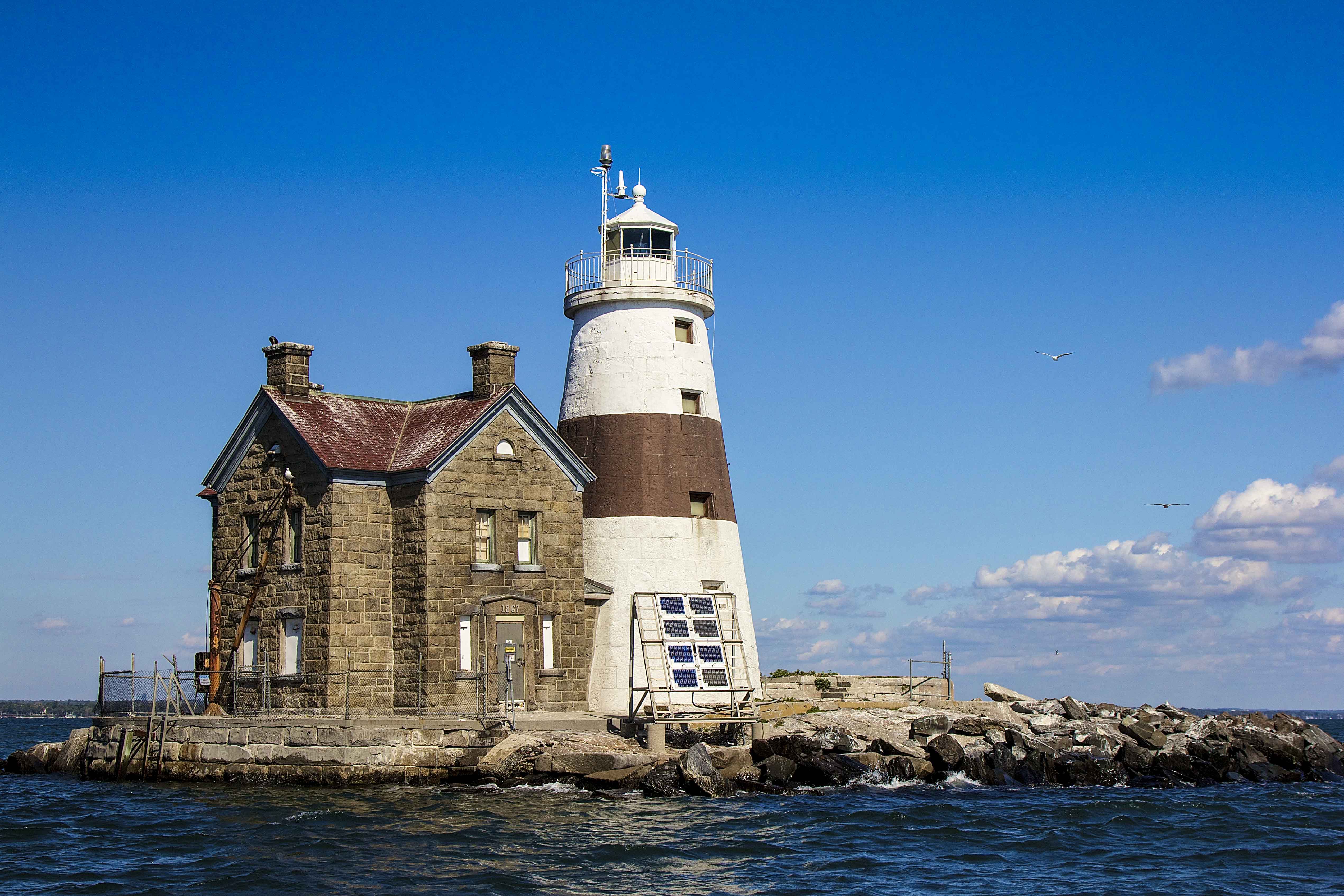


A beacon of light is designed to attract attention and signal a warning used in navigation, lighting the way for ships at sea.
Since the 1990s I've lived on City Island - A Sice of NYC Paradise. First, to build and launch News 12 The Bronx, https://bronx.news12.com/ - then AP Television North America https://apnews.com/hub/television Now, at Imaginus Media https://cimages.me/content/el-barbaro-del-medio and also educating students at US colleges and universities.
Of all the time-worn majestic structures flashing lights for the appreciated guidance of ships avoiding nautical dangers, two lighthouses along Long Island Sound have always triggered my curiosity and visually stood out for my sore eyes.
I had been trying to see these majestic structures for the longest time, but unfortunately, I had to navigate hurdles, roadblocks, and buoys. But finally, persistence paid off, and I could schedule this journey with two of my favorite local visual artists, Dick Sadler and Jimmy Breen.
Execution Rocks and Stepping Stones can be seen atop rock islands of the choppy blue expanse known as Long Island Sound, just east of Throgs Neck, south of City Island, and west of the westernmost edge of Long Island. Stepping Stones is the first lighthouse everyone encounters when entering the Sound from the East River. This red brick building was built in 1878 and looked like a small schoolhouse. It marks the edge of a shallow reef between The Bronx and Queens. A top-notch team of Coast Guard inspectors regularly visits these and other lighthouses four times yearly to ensure everything is in working order. But no one lives in these lighthouses. Solar panels and backup batteries power their navigational lights because there is no electricity.
On a sunny, windy day in early October, we three City Islanders and Jacob Quesnell, Mike Bonifas, Roberto Rivera, and Mike Cassidy, four U.S. Coast Guardsmen from the Secaucus, NJ station, set out from the dock, at Kings Point, just off the Sound, to check out these two iconic lighthouses. They allowed me and my crew to tag along. Requirements are a shallow-bottomed craft led by a captain with great eyes and a careful hand at the rudder. The only point of access to our first stop, Stepping Stones, is a salt-bitten metal ladder attached to the stone base of the lighthouse. In calm waters, the bobbing boat must be tethered to the ground with a hook to avoid swaying into half-submerged boulders on either side of the approach.
But this day, the choppy waters made it impossible and unsafe for our City Island team to leave the boat and enter the lighthouse. Therefore only two electricians went inside the small structure to perform preventive maintenance. Stepping Stone is surrounded by a chain-link fence, with white stone quoins and a black mansard roof. Broken shells from seagulls drop underfoot, and weeds grow inside the building's gutter of two. OfSCG officials banged on the rusty door to scare any rodents. Wrenching it open, the two entered, peering into the dim and humid structure.
The windows on the main floor of the lighthouse have long been boarded up. The crew inspected the bulbs, the batteries, and the connections. All were in working order, so we agreed to move on to our next destination. On the way to Execution Rocks, we passed under the City Island Bridge and watched those who are supposed to be hard at work there standing around doing very little. We took an up-close and personal look, but that is another story on another day. Mariners usually steer clear of every lighthouse because they often signal shallow water or other nautical hazards and are typically protected by rugged embankments. But our 26-foot boat bouncing over the chop in Long Island Sound cruised straight up, doing nearly 30 knots towards Execution Rocks, a lighthouse that sits by a shipping lane that leads out of the East River. As we arrived, we were impressed by the beauty of this infamous lighthouse. The boat was a steel-hulled United States Coast Guard vessel, which nosed up against the giant boulders surrounding the lighthouse, allowing the first two men to hop out. Both were first-class electricians who were conducting their regularly scheduled maintenance visits. They carried toolboxes and supplies over rocks stained white with bird droppings.
We then followed them with camera bags, tripods, and portable lights. After they opened and entered the padlocked door of the lighthouse, we quickly followed. Execution Rocks were sealed from the wind and waves, and the inside was eerily quiet. In one corner of the house, they rested old musical instruments that no longer make sounds. In the attic hung a ghost-like image from the ceiling that would become appropriate for anyone wacky enough to sail over at night to say "Trick or Treat." According to "folklore, folklorish avoided public executions in Colonial times because they would inflame the revolutionary spirit of the American people. Instead, they would carry the condemned to these reefs at low tide, chain them to rings embedded in the rock, and wait for high tide to carry out the death sentence. Some say the skeletons were left to torture the minds of the newly condemned as they faced certain death. The ghosts of the victims later had their revenge when a shipload of British soldiers, sent to pursue Washington on his retreat from Manhattan to White Plains, foundered at the reef, and no re, coats survived. Inside, fine dust covered the entire floor. At the far end of the structure, spiral staircases wound into the tower. Finding the bottom stairs was like playing hide-and-seek in an unfamiliar house. In the lantern room, however, sunlight poured in through giant glass panes, offering soaring and majestic views of the Sound. The beam occults lights every few seconds on and then off.
Checking the wiring, electricians of the Coast Guard stepped up to the signal apparatus, the mechanism that powers the light, flipped its cover, and contained the giant, clear morning. Inside Execution Rocks, we walked through the attached light keeper's house, the keeper's keeper's human being living there for over 30 years. We then mounted a 50 + foot granite tower via an ornate steel staircase leading to a small octagonal room with windows. In the center was a modern apparatus powered by a broad bank of solar panels, which sat outdoors. The electrician removed the top of the device and inspected a series of two-ampere bulbs that seemed much smaller than one might imagine a lighthouse lamp to be. If one burns out, a few bulbs are wired to activate the next one. The men then learned that the backup batteries, which were supposed to last ten years, had to be replaced prematurely. They also checked the bearings that allow the light to rotate fully every few seconds, making it appear to be blinking. These men try to bring an extensive selection of tools and parts on their visits because it's not like you're in the hardware store if you need to purchase something. We found the steel door to the balcony jammed, and with a firm kick, it was forced open the group walked out onto the circular walkway, which offered broad views of Westchester County, Connecticut, Long Island, and the Manhattan skyline. Execution Rocks and the other area lighthouses are inspected about every three months, said the Coast Guard senior chief and officer in charge of the team. He and his group document any structural damage suffered by the equipment it maintains.
After Hurricane Sandy steamrollered through, a coxswain found that an entire lighthouse, Old Orchard Shoal Light in Lower New York Bay, had been wiped out. On this day, the boat was idling off Execution Rocks as Dick Sadler took these magnificent photos, and Jimmy Breen shot a video, which will be seen later on. Meant, these dedicated electricians checked solar panels and batteries and a fog detector rigged to a foghorn. Electricians work together because their job requires them to be all buoys and towers to get to lights, which is difficult if the buoys are rocking.
Before leaving Execution Rocks, the men inspected and added water to the battery cells on a lower floor of the tower and found that several needed replacing. They joked about the legend that the lighthouse was haunted and how it had gotten its name from accounts of British colonial soldiers executing people by chaining them to the rocks and leaving them to drown in the rising tide. Despite its spooky history and ram-shackled condition, Execution Rocks is an exciting and unusual space. But the road to occupying and leaving it was rather bumpy and somewhat complicated because the waters became increasingly choppy throughout the day. This four-person tour-personal to the Coast Guard's aids-to-nGuard'son groups based in Bayonne, N.J., and maintain navigational aids from the Shrewsbury River in New Jersey through New York Harbor and up the Hudson River to West Point, as well as here in Long Island Sound. They inspect, maintain, and position more than 800 buoys in waterways in and around New York City equipped with some combination of lights, bells, gongs, and devices emitting radar signals. Team members also maintain the navigational equipment on nine major lighthouses, from Execution Rocks and Stepping Stones, south to Sandy Hook Light and Great Beds Light in Raritan Bay. Tens of thousands of commercial vessels pass these lighthouses each year, not counting the countless amounts of pleasure boats. We thank the men and women of The U.S. Coast Guard for their professional service. The USCG enjoys three themed areas. They are Safety, Security, and Stewardship that are explored through: Defenders of the Nation, Enforcers of the Seas, Lifesavers Around the Globe, Champions of Commerce, and Protectors of the Environment.
Meanwhile, the constantly rising seas and continuing erosion threaten lighthouses all around the #USA and the world. Volunteers and cash-strapped governments do what they can, but the level of concern, is just like the water, it keeps rising. eb546214d3794f83b7230cc0ece730d1 City Images wishes to thank the following U.S. Coast Guard personnel for their assistance and support. LT Karen Love Kutkiewicz BM2 (E-5) Jacob Quesnel - Coxswain Mk2 (E-5) Michael Bonifas - Crewman/ Engineer EM2 (E-5) Michael Cassidy - Crewman/ Engineer- Light House Tech EM1 (E-6) Roberto Rivera - Crewman/ Engineer- Light House Tech
Images: Dick Sadler. Long Island Sound Lighthouse Tour
#Vimeo #coastguard #lighthouse #cityisland #NYC
Video: J Breen
Executive Producer: Roberto FE Soto aka UB
MA Lighthouses
The Thacher Island Twin Lights are among Rockport's historic attractions for visitors http://bos.gl/uezv2xv
To Deborah Franklin; From Benjamin Franklin 17 July, 1757
The bell ringing for church, we went thither immediately, and with hearts full of gratitude, returned sincere thanks to God for the mercies we had received: were I a Roman Catholic, perhaps I should on this occasion vow to build a chapel to some saint; but as I am not, if I were to vow at all, it should be to build a lighthouse.
Angels On Earth
Goodness In Destruction - By Stephanie March https://kindnessblog.com/2015/11/02/angels-on-earth-goodness-in-destruc… via @KindnessBlog
The organization which has taken over one of these lighthouses is controlled by an angry and money hungry individual, who instead of sharing this treasure insists on shaking people down for exorbitant "donations" just to be able to visit the structure.